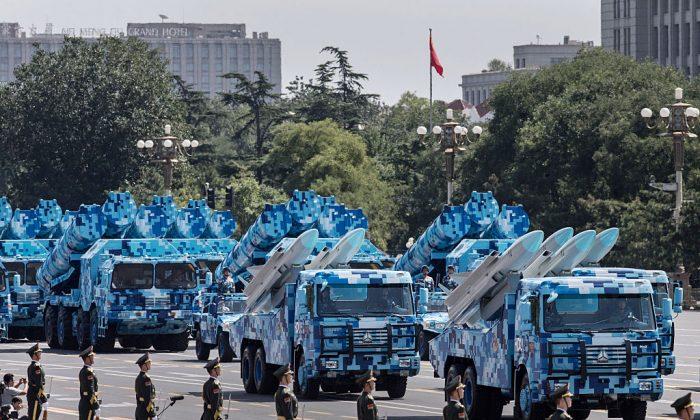The threat of China and its formidable arsenal of missiles is one of the major hurdles for U.S. defense under the Intermediate-Range Nuclear Force (INF) Treaty, according to a newly published congressional report.
China isn’t a signee to the treaty. However, “remaining outside the pact has allowed China to rapidly expand its missile arsenal as part of a military strategy designed to counter U.S. and allied military power in Asia,” the U.S.-China Economic and Security Review Commission (USCC) said in a report published Jan. 28 analyzing the implications of U.S. withdrawal from the treaty—just four days before the Trump administration formally announced that it would suspend its obligations under the treaty and begin the process to formally withdraw.
With the INF restrictions on the United States, Washington is unable to defend its interests in the Asian region, according to the report.
The INF treaty was signed by former U.S. President Ronald Reagan and Soviet General Secretary Mikhail Gorbachev in 1978, prohibiting both countries from deploying ground-launched ballistic and cruise missiles with ranges between 310 and 3,410 miles. This distance restricts U.S. missiles from reaching Asia.
The Feb. 1 announcement by the Trump administration explained that the United States has decided to pull out of the treaty after months of failed negotiations requesting that Russia dismantle its 9M729 ballistic missiles that the United States says breach the pact.
Though President Donald Trump and other officials had initially cited China’s missile capabilities as a rationale for withdrawing from the treaty—a point made throughout the USCC report—during a phone call with reporters on Feb. 1, an administration official denied such a connection, saying, “for the United States, this really doesn’t have anything to do with China. This is solely about Russia’s violation of this treaty.”The following day, Russia announced that it would also suspend participation in the treaty.
China Threat Under INF Restrictions
The USCC report pointed out that 95 percent of China’s inventory of more than 2,000 ballistic and cruise missiles—which includes short range (between 310 and 620 miles), medium range (620 and 1,860 miles), and intermediate range (1,860 and 3,410 miles)—would violate the INF Treaty, if China was a signatory.
While the majority of these Chinese missiles are fitted with conventional warheads, some are nuclear warheads and others are “dual-capable,” meaning the missile can be fitted for either a conventional or nuclear warhead, according to the report.
Without the restrictions under INF, Beijing has amassed missiles with the military strategy of holding “U.S. forces at risk should they choose to intervene in a regional conflict,” the report said.
The USCC painted a hypothetical situation for the United States, under INF restrictions.
If a regional conflict broke out over Taiwan or disputed islands in the East or the South China Sea, China could forestall or defeat U.S. intervention by “targeting regional U.S. military facilities as far out as Guam, along with naval and air assets operating offshore.”
The Chinese regime considers the self-ruled island of Taiwan part of its territory and has threatened the use of military force to unite it with the mainland.
The report noted that if the United States couldn’t intervene, U.S. allies in the Asia region would be at a disadvantage during a conflict, due to the “sheer number of Chinese missiles and the speed with which they could be fired.”
Furthermore, China would also be able to successfully stave off U.S. intervention if U.S. policymakers “become reluctant to keep fighting or sustain additional losses” as a result of the damage initially inflicted by Chinese missiles.
Any sign of the United States becoming less willing to intervene would serve Beijing’s ultimate purpose: to intimidate and coerce regional states, according to the report.
Response from China
When asked by reporters about the United States’ suspension on Feb. 2, Geng Shuang, China’s foreign ministry spokesperson, said that “China is opposed to the U.S. withdrawal” and warned that the withdrawal “may trigger a series of adverse consequences.”
When asked if China would agree to negotiate a new multilateral treaty on arms control to replace INF, Geng said, “China opposes the multilateralization of this treaty,” adding the Chinese regime believes it is imperative to “uphold and implement the existing treaty instead of creating a new one.”
Geng’s words were conservative compared to the scathing criticism by Chinese state-run media to denounce the U.S. decision.
Xinhua, in an editorial published Feb. 2, equated the U.S. withdrawal to “opening up a Pandora’s box,” as it would “seriously undermine global peace and security.”
“U.S. withdrawal leaves the entire human race with a negative outlook as they anticipate the 21st century,” the state-run newspaper Global Times said in an editorial on Feb. 2. The article also reiterated Beijing’s opposition to “any form of multilateralization under the INF, or any other forms of multilateralization demanded by Washington.”
The reason behind Beijing’s wariness of any multilateral framework was stated in the USCC report.
“Implicit in China’s official position [on opposition to multilateralization under INF] is an assessment that U.S. and Russian adherence to the INF Treaty, while China remains outside the pact, creates an asymmetry of arms control regimes that Beijing leverages to its advantage and therefore wants to maintain,” the report said.
Ramification
Ultimately, the United States would have one major advantage were it to withdraw from the INF: U.S. defense planners would have the additional option of putting ground-based missiles in the territories of its allies and partners in Asia to deter aggressive actions by Beijing, according to the report.
“It would force China to focus on destroying more targets in a conflict, thus diluting the amount of firepower the [People’s Liberation Army] could devote to any specific target,” the USCC said, adding that it would “complicate Chinese military planning.”
China already poses a threat to U.S. allies in Asia. SD Pradhan, former chairman of India’s Joint Intelligence Committee and former deputy national security adviser, wrote in an editorial published in India’s English-language daily newspaper The Times of India, that China is already placing “weapon systems in its periphery and its bases in the Indian Ocean,” in connection with its foreign policy of “One Belt, One Road” initiative (OBOR).
With the United States’ INF withdrawal, China could decide to accelerate that process, Pradhan said.
Beijing rolled out OBOR in 2013, with the objective of building up trade routes linking China, Southeast Asia, Africa, Europe, and Latin America by funding infrastructure projects in more than 60 countries.
Pradhan also warned that India needs to continue monitoring China’s missile deployment in Tibet, as well as the possibility of China placing new missiles in Pakistani territories.
Regardless of how China might respond after the U.S. withdrawal, China has already shown its willingness to use missiles for intimidation, according to the USCC report, such as when it fired missiles into the waters off Taiwan during the 1995-1996 Taiwan Strait Crisis.
China had fired the missiles to intimidate Taiwanese citizens just prior to the island holding its first presidential elections in 1996.
U.S. bimonthly magazine the National Interest, in an article published Jan. 4, identified ballistic missiles as one of five weapons China could use in a war against Taiwan. One of the Chinese missiles, DF-16, has a range of 1,000 kilometers (about 620 miles); can carry a 1,500-kilogram (about 3,307) warhead; and possesses a maneuvering capability that can evade interception by anti-ballistic missile systems.






Friends Read Free